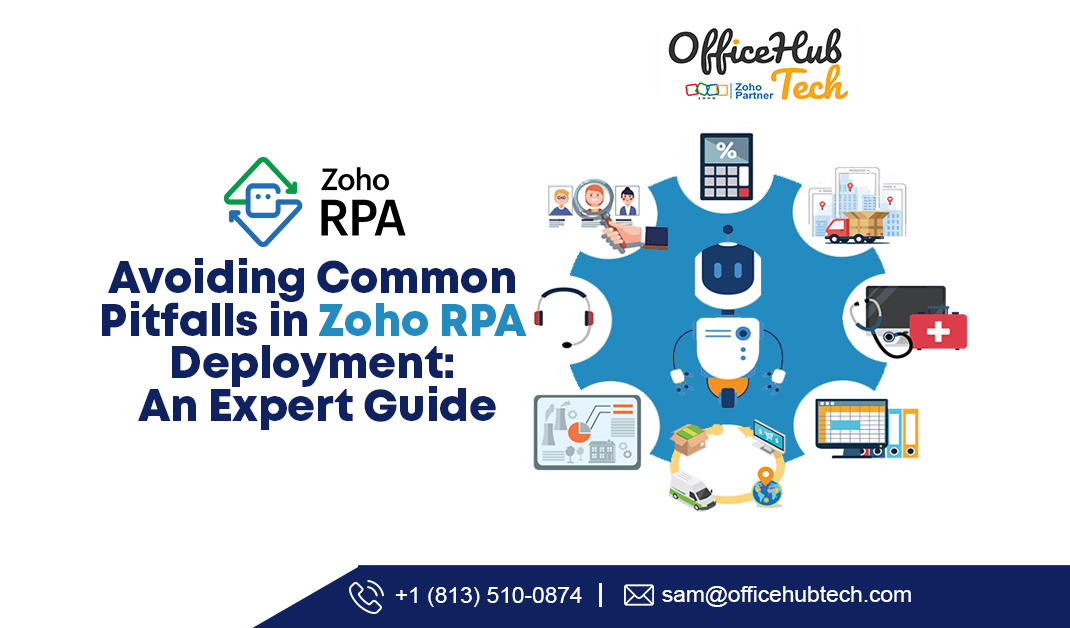
Avoiding Common Pitfalls in Zoho RPA Deployment: An Expert Guide
Introduction
Implementing Robotic Process Automation (RPA) is a transformative endeavor for any organization looking to enhance operational efficiency and reduce costs. However, while Zoho RPA promises significant benefits, its deployment is not without challenges. Many organizations encounter a range of pitfalls that can hinder the success of their RPA initiatives. This comprehensive guide explores these common pitfalls and provides detailed strategies to avoid them, drawing on expertise from best Zoho RPA developers in US.
Part 1: Identifying Common Pitfalls
-
Lack of Clear Strategy
A clear strategic direction is crucial for successful RPA deployment. Without it, organizations risk misaligning their RPA efforts with broader business objectives, leading to suboptimal outcomes and wasted resources.
-
Inadequate Process Selection
Choosing the wrong processes for automation can derail your RPA initiative before it even begins. Processes that are not standardized, overly complex, or low in volume may not yield the expected benefits.
-
Overlooking Change Management
The impact of RPA on the workforce is significant. Failure to manage this change effectively can lead to resistance from employees, undermining the adoption and utilization of RPA technologies.
-
Underestimating the Integration Complexity
Integrating RPA with existing IT systems can be more complex than anticipated. Many organizations fail to account for the intricacies involved in making RPA work seamlessly with legacy systems.
-
Ignoring Continuous Monitoring and Optimization
Deploying RPA is not a set-it-and-forget-it solution. Continuous monitoring and optimization are essential to address evolving challenges and ensure the technology continues to meet business needs effectively.
Part 2: Strategic Planning to Avoid Pitfalls
-
Developing a Comprehensive RPA Strategy
- Objective Setting: Define clear, measurable objectives for what you want to achieve with RPA.
- Scope Definition: Identify and document the specific processes that will be automated, focusing on those that are highly repetitive, prone to error, and time-consuming.
-
Detailed Process Assessment
- Process Mapping: Work with a certified Zoho RPA partner to map out the processes in detail, identifying any potential issues that could complicate automation.
- Feasibility Analysis: Conduct a thorough analysis to determine the automation readiness of each process and its potential ROI.
-
Robust Change Management
- Stakeholder Engagement: Engage all stakeholders early in the process, from top management to end-users, to garner support and facilitate smoother implementation.
- Training Programs: Develop comprehensive training programs to prepare employees for the transition, addressing both the use of new tools and adjustments in workflow.
Part 3: Implementation Best Practices
-
Choosing the Right RPA Tool
- Vendor Selection: Select an RPA tool that aligns well with your organization’s IT infrastructure and business needs. Certified Zoho RPA partners can provide valuable guidance in this selection process.
-
Pilot Testing
- Implementation of a Pilot Project: Start with a pilot project to test the RPA implementation in a controlled environment. This approach helps identify potential issues before a full-scale rollout.
-
Integration and Configuration
- Seamless Integration: Ensure that the RPA software integrates seamlessly with existing systems to facilitate smooth data flow and functionality.
- Custom Configuration: Customize the RPA tools to meet specific business needs, enhancing the effectiveness of automated processes.
Part 4: Ongoing Management and Optimization
-
Continuous Monitoring
- Performance Tracking: Regularly monitor the performance of RPA bots to ensure they are operating as expected and delivering value.
- KPIs and Metrics: Establish key performance indicators (KPIs) to measure the success of the RPA deployment.
-
Regular Updates and Maintenance
- Routine Updates: Schedule regular updates and maintenance to keep the RPA system running efficiently, adapting to any changes in the business environment or technology landscape.
Conclusion
Deploying Zoho RPA effectively requires careful planning, strategic process selection, robust change management, and ongoing optimization. By understanding and addressing these common pitfalls, organizations can enhance their chances of a successful RPA implementation, driving significant improvements in efficiency and productivity. This guide, rooted in the expertise of certified Zoho RPA partners, offers a comprehensive roadmap to navigate the complexities of RPA deployment and achieve sustained success.





